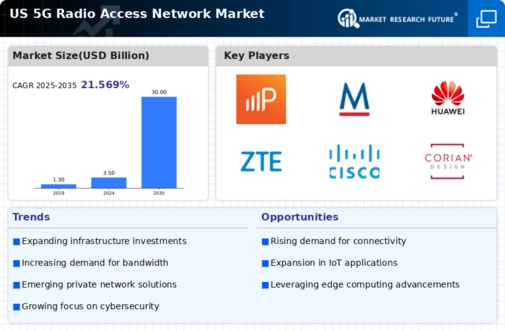Increased Adoption of IoT Devices
The increased adoption of Internet of Things (IoT) devices is a significant driver of the 5g radio-access-network market. As more devices become interconnected, the demand for reliable and high-speed networks intensifies. In the US, it is estimated that there will be over 75 billion IoT devices by 2025, creating a substantial need for advanced radio-access networks capable of handling massive data traffic. This proliferation of IoT applications, ranging from smart homes to industrial automation, necessitates the deployment of 5g networks to ensure seamless connectivity and real-time data processing. Consequently, the 5g radio-access-network market is poised for growth as service providers expand their infrastructure to accommodate the increasing number of connected devices and applications.
Government Initiatives and Funding
Government initiatives and funding play a crucial role in shaping the 5g radio-access-network market. Federal and state governments in the US are increasingly recognizing the importance of 5g technology for economic growth and national competitiveness. Various funding programs and grants are being established to support the deployment of 5g infrastructure, particularly in underserved areas. For instance, the Federal Communications Commission (FCC) has initiated programs aimed at promoting broadband access and enhancing network capabilities. These efforts are expected to facilitate the expansion of 5g networks across the country, thereby driving growth in the 5g radio-access-network market. As government support continues, it is likely that the market will see accelerated development and increased investment from both public and private sectors.
Rising Demand for High-Speed Connectivity
The increasing demand for high-speed connectivity is a primary driver of the 5g radio-access-network market. As consumers and businesses alike seek faster internet speeds, the need for robust infrastructure becomes evident. In the US, data consumption has surged, with mobile data traffic projected to reach 50 exabytes per month by 2025. This trend necessitates the deployment of advanced radio-access networks to support the growing number of connected devices. Moreover, industries such as healthcare, automotive, and entertainment are increasingly reliant on high-speed connectivity for applications like telemedicine, autonomous vehicles, and streaming services. Consequently, the 5g radio-access-network market is likely to experience substantial growth as service providers invest in enhancing their network capabilities to meet this escalating demand.
Competitive Landscape Among Service Providers
The competitive landscape among service providers is a driving force in the 5g radio-access-network market. As major telecommunications companies strive to capture market share, they are investing heavily in the expansion and enhancement of their 5g networks. This competition fosters innovation and accelerates the rollout of advanced technologies, which is beneficial for consumers and businesses alike. In the US, leading providers are racing to offer superior coverage and faster speeds, often resulting in aggressive pricing strategies and promotional offers. This dynamic environment is likely to stimulate further investment in the 5g radio-access-network market, as companies seek to differentiate themselves and meet the evolving demands of their customer base.
Technological Advancements in Network Equipment
Technological advancements in network equipment are significantly influencing the 5g radio-access-network market. Innovations in hardware and software are enabling more efficient and effective deployment of 5g networks. For instance, the introduction of Massive MIMO (Multiple Input Multiple Output) technology allows for improved capacity and coverage, which is essential for accommodating the increasing number of users and devices. Additionally, advancements in beamforming technology enhance signal quality and reduce interference, further optimizing network performance. As a result, the market for 5g radio-access-network equipment is projected to grow, with estimates suggesting a value of over $20 billion by 2026. These technological improvements are crucial for service providers aiming to deliver superior connectivity and maintain competitive advantages in a rapidly evolving landscape.

























Leave a Comment